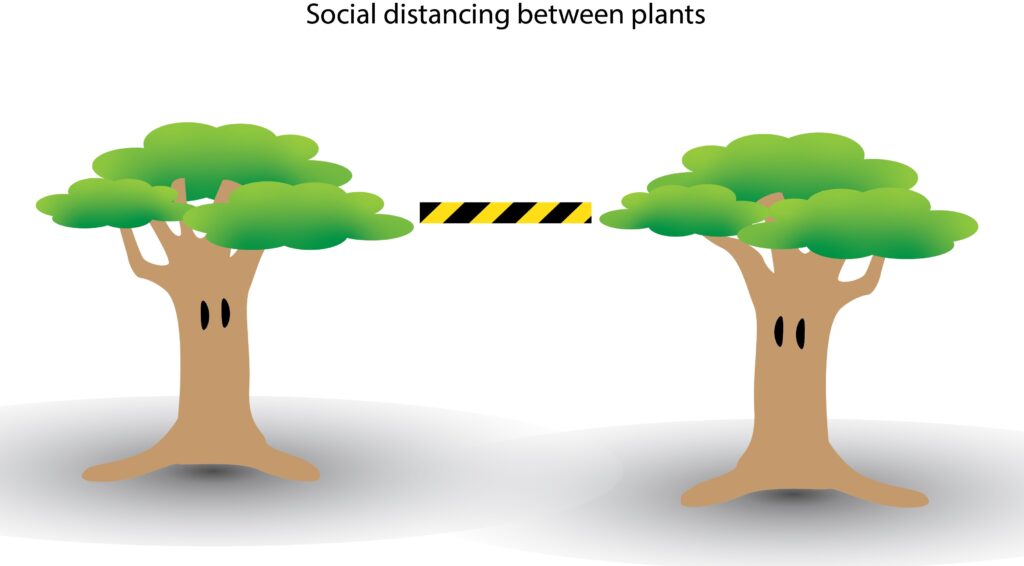The Covid-19 outbreak, the strike of one of the most contagious viruses in human history has caused a global pandemic with widespread infections around the world. The coronavirus spread so fast that people can get infected either through close contact with infected people, a few touches with an item’s surface that has viruses on it, or just staying in the same room with an infected person for a short time. Because of the airborne ability, this virus can harbor small and invisible particles in the air. When an infected person coughs without proper covering, the virus spread into the air and could possibly infect peoples six feet away. Apart from washing hands frequently with soap, it is also advised to wear a mask and meanwhile maintain a social distance between individuals for at least six feet. Social distancing has been a routine in 2020 and likely will impact our lifestyle for a long time. Nevertheless, social distancing is not just for humans but also common among other organisms. Few people realized that plants, as immobilized life also practice social distancing. Have you ever noticed there has no overlapping between plants of the same or different species? No grass or weeds are found around bushes or trees, and the canopy of the trees are not touching or overlapping each other. How do they achieve that?
Social distancing in plants has the same functions as humans, to protect themselves. Such a strategy helps minimize the competition for the resources in nature like nutrients, water, light, and space also to avoid diseases. In a forest, you will notice the crown of the trees claw at each other and then snap off some of their outermost leaves and branches to create a gap or space between each individual. The border around the treetop forms channel-like gaps, similar to the cracks on a dryland, posing naturally formed patterns. The phenomenon that crowns do not touch each other is called crown shyness, also known as canopy disengagement, canopy shyness, or intercrown spacing. Although the study of crown shyness started as early as 1920, the exact physiological basis has not been revealed in detail. Some hypothesize that the trees were simply failing to fill the spaces between their canopies due to a lack of light that acts as an essential resource for photosynthesis. Thus, leaving no foliage overlapping through reciprocal pruning. Growing new tissue is very costly for plants; therefore, they chose to avoid touching each other. Apart from lacking light due to foliage overlapping, broken branches due to the interaction stimulated by wind create wounds, leading to the formation of entries for virulent pathogens.
Most plant species are unlikely to survive under the canopy of the trees. Therefore, plants like mosses and epiphytes such as ferns, air plants, and orchids that require minimal light sources are often found to fill the blank around the tree. They usually have no “real roots” whereby the roots are used to anchor onto the rocks, branches of the tree, or other surfaces and are not used for absorbing nutrients. Such species absorb moisture from the air and surrounding environment and require minimal light and a small amount of or no nutrients to grow.
Another effective way for plants to stay “social distancing” is through a chemical defense mechanism which is called allelopathy. Allelopathic plants secrete chemicals to block seed germination or inhibit the growth of nearby plants. For instance, there is very little vegetation grows under a black walnut tree (Juglans nigra). It is also observed on the tropical plant like Imperata cylindrica. Seedlings often die when their roots come in contact with the root secretion of the mentioned trees. There is a wide range of varieties of allelochemicals, mostly are non-nutritive substances produced as secondary metabolites such as water-soluble organic acids, straight-chain alcohols, aliphatic aldehydes, and ketones; simple unsaturated lactones; long-chain fatty acids and polyacetylenes; benzoquinone, anthraquinone and complex quinones; simple phenols, benzoic acid, and its derivatives; cinnamic acid and its derivatives; coumarin; flavonoids; tannins; terpenoids and steroids; amino acids and peptides; alkaloids and cyanohydrins; sulfide and glucosinolates; and purines and nucleosides. Plant growth regulators including salicylic acid, gibberellic acid, and ethylene are also considered to be allelochemicals. In conventional agriculture when herbicides were not available. Allelopathic methods such as straw mulching using allelopathic plants as ground cover provide sustainable and environmentally friendly weed management.

Further readings:
Alan J. Rebertus. Crown Shyness in a Tropical Cloud Forest. Biotropica, Vol. 20, No. 4 (Dec., 1988), pp. 338-339Association for Tropical Biology and Conservation
Kong CH, Xuan TD, Khanh TD, Tran HD, Trung NT. Allelochemicals and Signaling Chemicals in Plants. Molecules. 2019;24(15):2737. Published 2019 Jul 27. doi:10.3390/molecules24152737